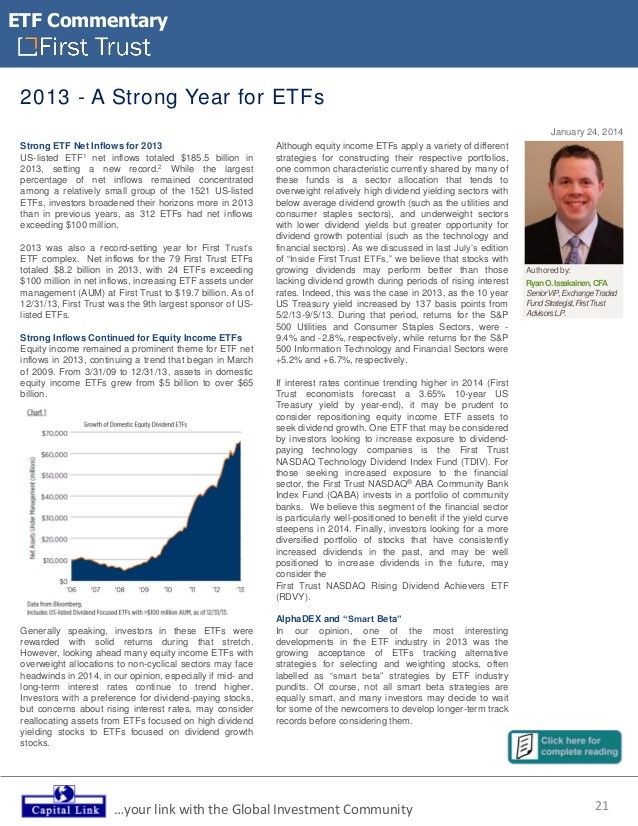These ETFs Track The Dow Jones Industrial Average_1
Post on: 29 Август, 2015 No Comment

Exchange Traded Funds
One of the few areas in the stock market that has attracted steadily rising investor interest is the use of exchange-traded funds (ETF�s). Hedge funds have been especially active in using these types of investments. The Appel companies use ETF’s to augment mutual fund trading.
In order to best discuss ETF�s we should start with a review of what a market index represents. An index is a collection of stocks selected to give a representative view of some part of the overall stock market. For example, the Dow Jones Industrial Average is a basket of 30 stocks designed to represent the various sectors of the U.S. economy. The S&P 500 is a much large group (500 stocks) that represents the behavior of large, publicly traded U.S. companies.
The stocks within an index and the weight given to each stock in calculating the value of each index are fixed from day to day. The companies that sponsor the various indexes make changes to their composition either at regular intervals (the S&P 500) or infrequently (the Dow Jones Industrial Average). In contrast, a manager of an actively managed mutual fund can change his or her stock holdings at any time, in fact, the average stock fund manager turns over almost his entire portfolio in a year, while changes in stock index composition are far smaller than that.
Investments designed to track the movements of stock market indexes are important for individual investors because historically, index-based investments have outperformed a majority of actively managed mutual funds.
ETF�s are a rich source of index investments. Like an index mutual fund, ETF�s hold baskets of stocks designed to track the movements of a stock market index, and are constrained by the composition of the index they track. There are currently far more index investments available through ETF�s than through traditional closed end mutual funds. ETF�s track a variety of indexes, including those which represent small companies, mid-sized companies, large companies, companies expected to grow faster than the market, companies selling more cheaply than the overall market, foreign companies�even bond market segments.
In many cases, more than one index investment is available for any given investment style, which can give you the chance to pick the better-performing index. For example, small cap investors have the option of investing in ETF�s that track either the S&P 600 Small Cap Index (IJR) or the Russell 2000 Small Cap Index (IWM). This sort of flexibility is not available through index mutual funds.
Where ETF�s and open-end index funds differ is that ETF�s trade on stock exchanges throughout the day. They are subject to the laws of supply and demand, and on occasion the price of an ETF share may differ from the value of the underlying basket of stocks. Index mutual funds trade only at the end of the day. Regardless of the balance of buyers and sellers, the price of a share of an index mutual fund is equal to the value of the underlying basket of stocks.
Should you choose ETF�s or index funds?
The disadvantage of ETF�s is that they carry the same trading costs involved in buying and selling individual stocks. Depending on your arrangements with a broker and on the particular ETF involved, these costs can be significant, in some cases reaching �% per trade. Most no-load mutual funds do not have per-trade costs (unless you execute transactions through one of the mutual fund supermarkets). If you are adding small amounts of money at regular intervals to your investments, an index mutual fund might be the better alternative.
The advantages of ETF�s include their much greater variety, and their very low holding expenses. Mutual funds charge expense ratios to cover their costs of operation. Actively managed U.S. stock funds charge an average of 1% per year. Broad-based ETF�s charge less. Many traditional index mutual funds have low expense ratios too, but in general ETF�s are the least expensive long term investment.
How you should use ETF�s
Most individual investors should use ETF�s when implementing their asset allocation strategy. Since index fund investments have tended to outperform actively managed funds, consider ETF�s for the different investment styles in which you might looking to participate. Of course, there is no guarantee that any ETF�s will outperform the typical actively managed fund in the same area, nor that exposure to any particular investment will ultimately be profitable to you during your holding period.
Specific examples include: SPY for your large U.S. company investments, IJR (S&P 600 small company index) for your small-cap investments, and QQQ (Nasdaq 100 Depository Receipt) for technology exposure.














